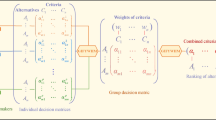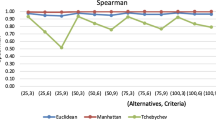Abstract
Double hierarchy hesitant fuzzy linguistic term set (DHHFLTS) is a newly developed complex linguistic expression model, and has been well applied to multi-criteria decision-making (MCDM) problems. However, the determination of criteria weights and the innovation of decision-making methods are still two issues that worth exploring in this field. At present, conventional weight-determination methods sometimes have the disadvantages of complicated calculation and low consistency of the obtained results. On the other hand, the existing methods for linguistic information sometimes cannot consider the uncertainty of information caused by ignorance. Considering that the best-worst method (BWM) is a weight-determination method, which can not only greatly simplify the calculation process, but also improve the consistency degree of the results. Dempster-Shafer evidence theory (DSET) can better deal with information uncertainty caused by ignorance. Therefore, this paper extends the BWM and DSET to double hierarchy hesitant fuzzy linguistic environment to solve the above two problems respectively, and the DHHFL-BWM-DSET method is proposed. First, the weight of each criterion is derived based on the BWM-based weight-determination method. Then, inspired by DSET, we propose a DSET-based MCDM method which can not only obtain the decision results of a single decision maker, but also integrate the decision information of multiple decision makers to obtain more rational results. Therefore, decision makers can choose the method based on the specific situation. Finally, taking the selection of financial products as an example, it shows that the method proposed in this paper has some breakthroughs and advantages.


Similar content being viewed by others
References
Zadeh LA (1975) The concept of a linguistic variable and its application to approximate reasoning-part 1. Inf Sci 8(3):199–249
Herrera F, Martínez L (2000) A 2-tuple fuzzy linguistic representation model for computing with words. IEEE Trans Fuzzy Syst 8(6):746–752
Türkşen IB (2002) Type 2 representation and reasoning for CWW. Fuzzy Sets Syst 127:17–36
Wang JH, Hao J (2006) A new version of 2-tuple fuzzy linguistic representation model for computing with words. IEEE Trans Fuzzy Syst 14:435–445
Rodríguez RM, Martínez L, Herrera F (2012) Hesitant fuzzy linguistic term sets for decision-making. IEEE Trans Fuzzy Syst 20:109–119
Wang H (2015) Extended hesitant fuzzy linguistic term sets and their aggregation in group decision making. Int J Comput Int Sys 8:14–33
Pang Q, Wang H, Xu ZS (2016) Probabilistic linguistic term sets in multi-attribute group decision making. Inf Sci 369:128–143
Zhu H, Zhao JB, Xu Y (2016) 2-dimension linguistic computational model with 2-tuples for multi-attribute group decision making. Knowl Based Syst 103:132–142
Gou XJ, Liao HC, Xu ZS, Herrera F (2017) Double hierarchy hesitant fuzzy linguistic term set and MULTIMOORA method: a case of study to evaluate the implementation status of haze controlling measures. Inf Fusion 38:22–34
Wang XX, Xu ZS, Gou XJ (2019) Nested probabilistic-numerical linguistic term sets in two-stage multi-attribute group decision making. Appl Intell 49:2582–2602
Torra V (2010) Hesitant fuzzy sets. Int J Intell Syst 25(6):529–539
Krishankumar R, Subrajaa LS, Ravichandran KS, Kar S, Saeid AB (2019) A framework for multi-attribute group decision-making using double hierarchy hesitant fuzzy linguistic term set. Int J Fuzzy Syst 21:1130–1143
Xu ZS, Xia MM (2011) Distance and similarity measures for hesitant fuzzy sets. Inf Sci 181:2128–2138
Arevalillo-Herráez M, Ferri FJ, Domingo J (2013) A naive relevance feedback model for content-based image retrieval using multiple similarity measures. Pattern Recogn 43(3):619–629
Zenebe A, Norcio AF (2009) Representation, similarity measures and aggregation methods using fuzzy sets for content-based recommender systems. Fuzzy Sets Syst 160(1):76–94
Ghazanfar MA, Prügel-Bennett (2014) A leveraging clustering approaches to solve the gray-sheep users problem in recommender systems. Expert Syst Appl 41(7):3261–3275
Gou XJ, Xu ZS, Liao HC, Herrera F (2018) Multiple criteria decision-making based on distance and similarity measures with double hierarchy hesitant fuzzy linguistic term sets. Comput Ind Eng 126:516–530
Gou XJ, Liao HC, Xu ZS, Min R, Herrera F (2019) Group decision making with double hierarchy hesitant fuzzy linguistic preference relations: consistency based measures, index and repairing algorithms and decision model. Inf Sci 489:93–112
Gou XJ, Xu ZS, Liao HC, Herrera F (2020) Consensus model handling minority opinions and noncooperative behaviors in large-scale group decision-making under double hierarchy linguistic preference relations. IEEE Trans Cybern:1–14. https://doi.org/10.1109/TCYB.2020.2985069
Gou XJ, Liao HC, Wang XX, Xu ZS, Herrera F (2020) Consensus based on multiplicative consistent double hierarchy linguistic preferences: venture capital in real estate market. Int J Strateg Prop M 42(1):1–23
Wang XD, Gou XJ, Xu ZS (2020) Assessment of traffic congestion with ORESTE method under double hierarchy hesitant fuzzy linguistic environment. Appl Soft Comput 86:105864
Liu NN, He Y, Xu ZS (2019) Evaluate public-private-partnership’s advancement using double hierarchy hesitant fuzzy linguistic PROMETHEE with subjective and objective information from stakeholder perspective. Technol Econ Dev Econ 25(3):386–420
Fu ZG, Liao HC (2019) Unbalanced double hierarchy linguistic term set: the TOPSIS method for multi-expert qualitative decision making involving green mine selection. Inf Fusion 51:271–286
Montserrat-Adell J, Xu ZS, Gou XJ, Agell N (2019) Free double hierarchy hesitant fuzzy linguistic term sets: an application on raking alternatives in GD. Inf Fusion 47:45–59
Gou XJ, Xu ZS, Zhou W (2020) Managing consensus by multiple stages optimization models with linguistic preference orderings and double hierarchy linguistic preferences. Technol Econ Dev Econ 26:642–674. https://doi.org/10.3846/tede.2020.12013
Gou XJ, Xu ZS, Wang XX, Liao HC (2020) Managing consensus reaching process with self-confident double hierarchy linguistic preference relations in group decision making. Fuzzy Optim Decis Ma Accept
Gou XJ, Liao HC, Xu ZS, Herrera F (2019) Probabilistic double hierarchy linguistic term set and its use for designing a VIKOR method for smart healthcare. J Oper Res Soc Tech Res
Saaty TL (1977) A scaling method for priorities in hierarchical structures. J Math Psychol 15:234–281
Rezaei J (2015) Best-worst multi-criteria decision-making method. Omega 53:49–57
Mi XM, Tang M, Liao HC, Shen WJ, Benjamin L (2019) The state-of-the-art survey on integrations and applications of the best worst method in decision making: why, what, what for and what’s next? Omega 87:205–225
Mou Q, Xu ZS, Liao HC (2016) An intuitionistic fuzzy multiplicative best-worst method for multi-criteria group decision making. Inf Sci 374:224–239
Mou Q, Xu ZS, Liao HC (2017) A graph based group decision making approach with intuitionistic fuzzy preference relations. Comput Ind Eng 110:138–150
Guo S, Zhao HR (2017) Fuzzy best-worst multi-criteria decision-making method and its applications. Knowl Based Syst 121:23–31
Nie RX, Tian ZP, Wang JQ, Zhang HY, Wang TL (2018) Water security sustainability evaluation: applying a multistage decision support framework in industrial region. J Clean Prod 196:1681–1704
Aboutorab H, Saberi M, Asadabadi MR, Hussain O, Chang E (2018) ZBWM: the Z-number extension of best worst method and its application for supplier development. Expert Syst Appl 107:115–125
Li J, Wang J, Hu J (2019) Multi-criteria decision-making method based on dominance degree and BWM with probabilistic hesitant fuzzy information. Int J Mach Learn Cyb 10:1671–1685
Mi XM, Liao HC (2019) An integrated approach to multiple criteria decision making based on the average solution and normalized weights of criteria deduced by the hesitant fuzzy best worst method. Comput Ind Eng 133:83–94
Dempster AP (1967) Upper and lower probabilities induced by a multi-valued mapping. Ann I Stat Math 38(2):325–339
Shafer GA (1976) A mathematical theory of evidence. Princeton University Press
Yager RR (1982) Generalized probabilities of fuzzy events from fuzzy belief structures. Inf Sci 28(1):45–62
Yang JB, Wang YM, Xu DL, Chin KS (2006) The evidential reasoning approach for MADA under both probabilistic and fuzzy uncertainties. Eur J Oper Res 171(1):309–343
Chai KC, Tay KM, Lim CP (2016) A new method to rank fuzzy numbers using Dempster–Shafer theory with fuzzy targets. Inf Sci 346-347:302–317
Casanovas M, Merigó JM (2012) Fuzzy aggregation operators in decision making with Dempster–Shafer belief structure. Expert Syst Appl 39(8):7138–7149
Liu PD, Gao H (2019) Some intuitionistic fuzzy power Bonferroni mean operators in the framework of Dempster–Shafer theory and their application to multicriteria decision making. Appl Soft Comput 85:105790
Li X, Chen X (2019) Belief structure-based induced aggregation operators in decision making with hesitant fuzzy information. Neural Comput Appl 31(12):8917–8929
Merigó JM, Casanovas M, Martínez L (2010) Linguistic aggregation operators for linguistic decision making based on the Dempster-Shafer theory of evidence. Int J Uncertain Fuzz 18(03):287–304
Wei GW, Zhao XF, Lin R (2013) Some hybrid aggregating operators in linguistic decision making with Dempster–Shafer belief structure. Comput Ind Eng 65(4):646–651
Liu PD, Zhang XH (2020) A new hesitant fuzzy linguistic approach for multiple attribute decision making based on Dempster–Shafer evidence theory. Appl Soft Comput 86:105897
Fang R, Liao HC, Yang JB, Xu DL (2019) Generalised probabilistic linguistic evidential reasoning approach for multi-criteria decision-making under uncertainty. J Oper Res Soc 71(5):700–717
Deng Y (2012) D numbers: theory and applications. J Inf Comput Sci 9(9):2421–2428
Deng XY, Weng J (2019) A new method to rank fuzzy numbers using Dempster–Shafer theory with fuzzy targets. Int J Approx Reason 106:194–213
Rezaei J (2016) Best-worst multi-criteria decision-making method: some properties and a linear model. Omega 64:126–130
Yang JB (2001) Rule and utility-based evidential reasoning approach for multiattribute decision analysis under uncertainties. Eur J Oper Res 131(1):31–61
Lyu B, Li GQ (2005) Personal financial planning theory and practice. Shanghai University Press
Acknowledgements
This study was funded by the National Natural Science Foundation of China (Nos. 71771155, 71571123), and the Fundamental Research Funds for the Central Universities (Nos. YJ202015, SXYPY202038).
Author information
Authors and Affiliations
Corresponding author
Additional information
Publisher’s note
Springer Nature remains neutral with regard to jurisdictional claims in published maps and institutional affiliations.
Rights and permissions
About this article
Cite this article
Zhang, R., Xu, Z. & Gou, X. An integrated method for multi-criteria decision-making based on the best-worst method and Dempster-Shafer evidence theory under double hierarchy hesitant fuzzy linguistic environment. Appl Intell 51, 713–735 (2021). https://doi.org/10.1007/s10489-020-01777-2
Published:
Issue Date:
DOI: https://doi.org/10.1007/s10489-020-01777-2




